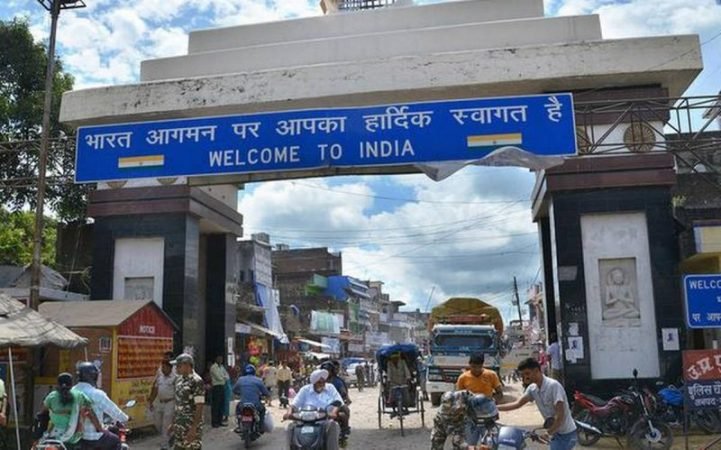Nepal-India inaugurates new strategic road connecting Indo-Nepal border

Nepal-India jointly inaugurated 104 km long road connecting India to the Himalayan Region. The road improves and strengthens the connectivity between Laxmipur-Balara (India) to Gadhiya in Sarlahi district (Nepal) which was jointly inaugurated by Nitesh Kumar, Counsel General of the Consulate General of India, Birgunj and Binod Kumar Mauwar, Division Chief of Department of Roads, Chandranighapur as per the statement issued by the Indian embassy in Kathmandu. The development of road is considered as the high community development project.
The Government of India has aided of Rs 4.4 Crores ($60,000) for construction of this blacktopped road under Nepal-Bharat Development cooperation. The Embassy of India in Kathmandu signed an MOU with the Division Road Office, Department of Roads, Ministry of physical and Infrastructure Development, Government of Nepal road. The embassy expressed optimism that this strategic development will bring ease to daily commuters and will forge a robust relationship between both the nations. “The project is a reflection of India’s development partnership with Nepal and complements the effort of the Government of Nepal in strengthening infrastructure,” said the press statement.
Blow-out of Lipulekh Pass
This initiative comes into being after the recent Indo-Nepal blow out over Lipulekh Pass in 2020.
Lipulekh is a Himalayan pass at the tri-junction between three state borders – Uttarakhand state of India, China’s Tibetan Autonomous Region and the disputed Kalapani territory. Currently, the Kalapani territory (southern side of Lipulekh pass) is controlled by India, while Nepal condemns India’s aggressive encroachment as it sets to defy Anglo-Nepal’s Sugauli Treaty of 1816 which demarcates the lowland between River Kali (formed by two headwaters Kalapani river – origin Lipulekh Pass and the Kuthi Yankit – origin Limpiyadhura range.) and Rapti within Nepalese Territory.
Nepal claims that during 1962 Indo-China War, as a friendly neighbour it permitted Indian Army to set up a camp in Kalapani region, however, post-1962 war, despite firm requests by Nepal’s PM’s the Indian Army did not evacuate the region, leading to the emergence of Kalapani Dispute. Later in coming times, India carried three escalators measures to which Nepal objected, quoting it as ‘India’s hegemonic design’. Firstly, in May 2015 a Sino-Indo agreement was signed to use Lipulekh pass for trade to which Kathmandu protested. Secondly, in 2019 India published a new map showing Kalapani within its territory and lastly the final blow-out amidst COVID-19 as in 2020 Indian Defence Minister Rajnath Singh inaugurated an 80-km road linking Uttarakhand’s region Dharchula to Kailash-Mansarover in Tibet via Lipulekh Pass to which Nepal bluntly reacted claiming that the road passes through Nepalese territory and officially issued a new map showing Lipulekh, Kalapani and Limpiyadhura as parts of their territory as per Sugauli Treaty (1816), thus straining India-Nepal’s bilateral ties further.
Given the strategic location of Lipulekh Pass near the Line of Actual Control (LAC) has benefited Delhi as surveillance access to have an eye on Chinese movement especially as the Pass is near the Chinese trading town Taklakot or Purang. However, at the same time, Nepal’s disputed territory sees itself caught up between the rivalry of two Asian Giants, as witnessed in recent Indo-China military standoff, compelling Oli’s government to assert its claim over the disputed territory more firmly to secure sovereignty and security of Nepal.

However, as China is also trying to vow Kathmandu, India has realised the strategic importance of Nepal in the fragile world politics. Despite the bone of contention over Lipulekh (Kalapani Territory), both the countries have consistently reiterated for a failure dialogue over the issue and robustly rejected any “third party” intervention. Further, the Government of India has been adamantly developing and strengthening border infrastructure in Nepal’s Terai area through up-gradation of 10 roads in the region and assisting Nepal in development of cross border rail link at Jogbani-Biratnagar, Jayanagar-Paribas. Though in 2020 both the countries witnessed a sour relationship but in 2021 when the nations around the world geared up to insulate and inoculate its citizens from Covid-19, India judiciously used this opportunity to strengthen its relations with its neighbours and assisted Nepal with 12 million doses of vaccines which have strengthened the amicable relations between both the countries.
Hence, the current exigency for both the countries is to respect their People to People ties, underscore democratic values and boost infrastructural development to cement a positive and robust relationships.


















